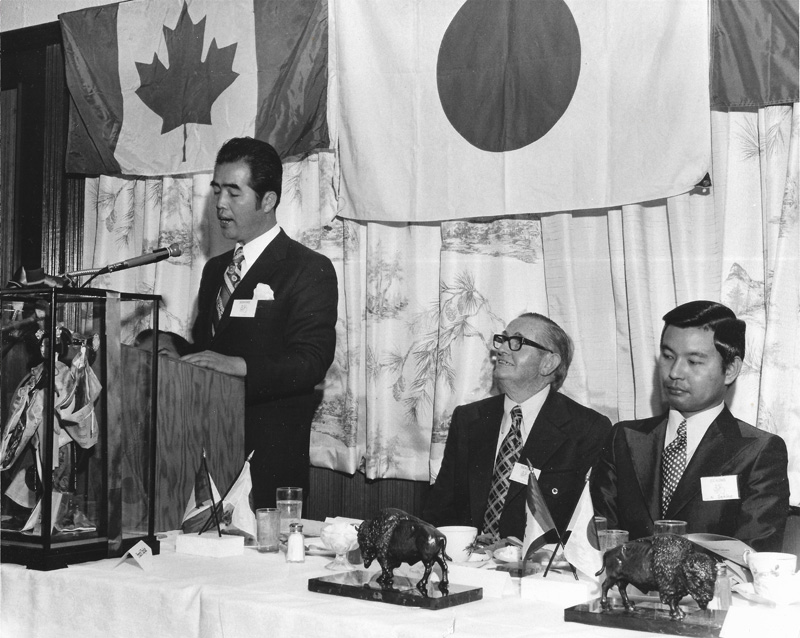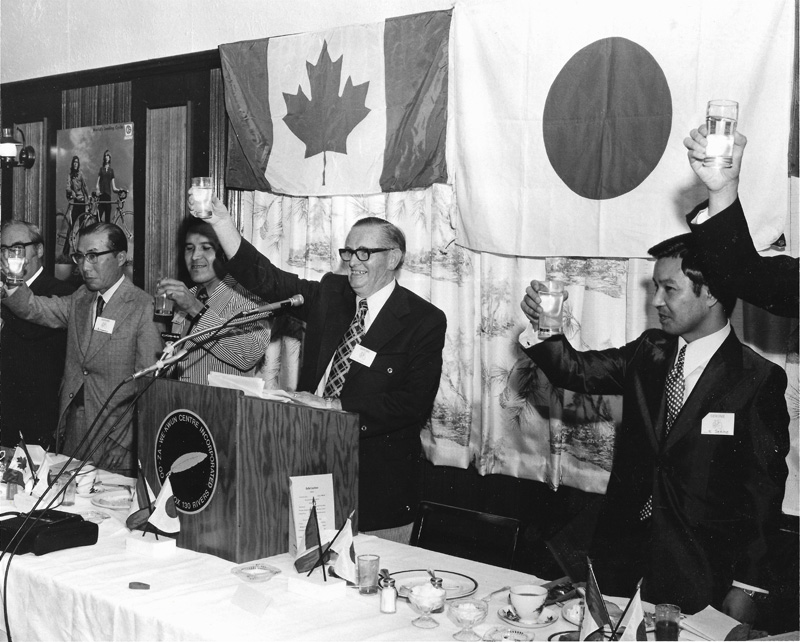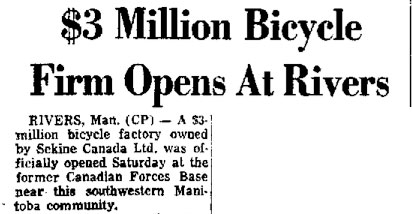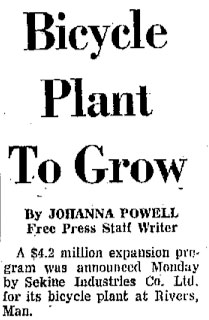

|

|
|
Part
3: Setting the Wheels in Motion

Establishment
With cycling experiencing a boom, Canada’s small bike industry couldn’t
supply the demand. Consumers wanted new, sleek ten-speeds – more like
the expensive racing bikes produced in Europe.
Sekine was in a position to provided bikes that approached that
quality, but at a lower price. In 1971 Acklands Ltd. Of Winnipeg began
importing and distributing Sekines. H.C. Paul and Co., a subsidiary
that oversaw the leisure products division, saw a dramatic increase in
sales.
Imported bicycles into Canada had tripled in the previous three years,
reaching a combined total of 450,000 last year - that he was having
trouble getting deliveries on the 25,000 or so Sekine bicycles he was
distributing through western Canada. So he pitched the idea to
the Sekine people — why not start a plant and make the bikes in Canada?
Another key figure was Bert Luckhurst, of Resource Development
Associates in Winnipeg, business consultants for the Oo-Za-We Kwun, who
suggested the abandoned Rivers air force base, now home to the a
training centre tor Aboriginal Manitobans, as the site for the
plant. Mr. Luckhurst, at the time, told a Free Press reporter
that: “We think the idea should work well. A good percentage of the
employees — there'll be about 40 to start with, but this should
increase to 100 once actual manufacture gets underway next year — will
be Indians in the area. Employment and training for those who wish it
is the point of Oo-Za-We-Kwun. The Sekine people are expected to bring
about three key executives to work in the plant, and some engineers to
get it started. After that, they'll rely on local labour.”
Negotiations went on for about a year, with Sekine executives making
several trips lo Canada lo look over the site. Somewhere along
the way, DREE (The Department of Regional Economic Expansion) was
approached for a $450,000 incentive grant to help Sekine renovate
an old hangar into a $1 million factory.
Apparently one feature of the set-up that appealed to the Japanese was
that the plant would be in a "controlled environment," rather like an
industrial park, which helps foster the Japanese idea of workers, being
treated more like a family than is the case in North America.
The availability of 400 unoccupied houses adjacent to the facility
which would be leased to Sekine personnel "at modest rents," was
another inducement for the company to come.
In October of 1972 extensive negotiations took place involving Manitoba
Economic Development officials, Mr. Paul, and Sekine representatives.
There were visits to Japan and the Sekine executives visited the
Oo-Za-We-Kwun Centre. Sekine was at that time looking at several
options.
On Nov. 22, 1972 the Winnipeg Free Press reported that Frank Price, the
manager of the Oo-Za-We-Kwun native training centre in Rivers announced
an agreement in principle to locate the enterprise on the abandoned
Forces base close to Rivers.
Initial production was projected to be about 50,000 bicycles a year. At
first, the bikes — three, four and ten-speed models — were only
assembled at Rivers, with parts shipped from Japan.
"The main advantage at first will be that parts will be available for
servicing," said a spokesman at H. C. Paul at the time.
Eventually, the idea was to have Sekine manufacture the bikes from
scratch at Rivers, and to supply a North American market that could
reach three million machines annually.
In April of 1973, Sekine Industries, Nagase and Co. (and import-export
company). AndH.C.Paul Co. formed the joint venture Sekine Canada Ltd.
And announced plans to build a $1.2 million plant in an aircraft hangar
on the Oo-Za-We-Kwun Centre.
Over that summer equipment and engineers arrived from Japan and the
huge hangar was converted into an assembly line, offices, and storage
facilities.
Soon after the announcement of the deal there was an interesting
wrinkle in the story. Osmond Mellon, who hoped to manufacture bicycles
in Winnipeg, claimed that some proposed changes on bike safety
regulations were designed to favour the Japanese company. It seem that
Sekine was one of the few companies that could meet certain of the new
regulations.
The regulations were proposed by Professor David Anderson of the
University of Winnipeg who was commissioned by the Provincial
Government. He proposed a "double braking system" as a safety feature.
He denied any political motivation and claimed he had never heard of
Sekine when making his proposals. Mr. Mellon said the innovation is not
used in Europe, long accepted as leaders in bicycle engineering.
Minor controversies aside, the first 250 bicycles were shipped on
Monday, August 20th.
September 8th, 1973 saw the grand opening with a staff of 43 Aboriginal
employees and 10 Japanese technicians. Officials toured the plant.
Invited officials attended a reception at the former Officer’s Mess
Building. Sekine President N. Sekine attended and gave a speech.
Long-term plans included a growth in the work force to 200 employees
with sales of $20 million a year. As proposed, the plant was a joint
venture with the newly formed Seking Canada Ltd. manufacturing the
bikes, Nagase and Co., a marketing the bikes in the U.S., and Winnipeg
firm H.C. Paul, handling marketing in Winnipeg and Canada. Rivers would
be home to the North American headquarters of Sekine Canada. Ltd.

Opening of Sekine Bike Plant at Officer's Mess. At the Podium
- the Manager at Sekine, beside him, Frank Taylor, and a
Japanese Representative
The Grand Opening in Rivers was presided over by Len Evans, Manitoba's
Minister of Industry and Commerce and Nobuyoshi Sekine, the President
of Sekine Canada.

Mayor Frank Taylor - at the opening of Sekine
Bike Plant
Prior to the opening senior officials of the Manitoba Department of
Industry and Commerce had visited Japan to outline marketing and
feasibility studies. The Federal Department of Economic Expansion
provided a $350000 incentive grant with the start of production.
Along with the aggressive marketing campaign came news of the promised
expansion. H.C. Paul, Sekine board chairman announced that a 4.2
million dollars expansion would see seventy-five jobs added to the
workforce. Aboriginal workers made up 75% of the workforce, and Dr.
Ahab Spence, Manitoba Indian Brotherhood president was appointed to the
Board of Sekine Canada.


IAlong with adding new equipment the company was seeking to increase
the Canadian content of its bikes. Buying Canadian - made tires could
save the company $150000 a year.
In addition to the partnership outlined above, the venture was also
affiliated with the Manitoba Indian Brotherhood, governments, and local
people looking for options after the Canadian Forces Base closed in
1971. As collaboration with Manitoba's aboriginal people and with the
Oo-Za-We-Kwun native training centre, it promised to be a success.
Workers selected from communities across Manitoba were given a
two-month orientation before moving on the factory floor. Mr. Paul
reported that he observed a good working environment. Although the
following remarks seem a bit paternalistic today, we can suppose he
meant well when he said:
"The Indian has always been a craftsman, he has thousands of years of
experience behind him not being given a chance for expression". "Five
employees have proven so skillful that they have been promotes to
suprevisory positions."
Plans were already in the works for a U.D. Office in Fond du Lac
Wisconsin and there was a general optimism about an expanding market.
On June 19, 1974 the Free Press reported that Sekine Canada Ltd. held
its first annual board meeting at the Mercantile Bank in Winnipeg.
Attendees included Rinzo Hoh of Tokyo, Sekine Vice President, and
Mitsuaki Kumori of Rivers, Sekine Canada President and Board President,
along with senior management from Tokyo, Osaka, Winnipeg and Rivers.
It was at that meeting the Dr. Ahab Spence was appointed to the Board.
Dr. Spence, a Cree, was born in Split Lake in 1911. After graduating
from the University of Saskatoon he worked as a Minister and Teacher in
Indian Missions for twenty-eight years. He served as a canon and
archdeacon with the Anglican Church and as a Residential School
Principal in Sioux Lookout Ontario. He then became an Officer with the
Department of Indian Affairs and a President of the Manitoba Indian
Brotherhood. Dr. Spence was awarded an honourary LLB Degree from the
University of Saskatoon in 1964 and a Centennial Medal in 1967.
In 1974 a Japanese TV crew began preparing to shoot a documentary on
the Sekine plant. Director Hirushi Sasaki indicated the project hoped
to go beyond reporting on the Sekine plant, and explore the story of
Canada's Aboriginal People.

|
|